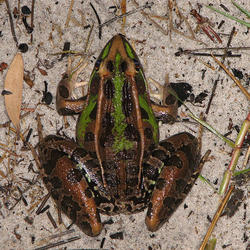Environmental Toxicology
Environmental Toxicology
Filter Total Items: 72
Advanced PFAS Measurement Methods
Environmental Health Program scientists, in collaboration with other USGS scientists, are developing complementary field and laboratory methods and capabilities to detect and quantify a range of target and nontarget per- and polyfluoroalkyl substances (PFAS) and indicator compounds at low levels (parts per trillion) in a variety of environmental matrices. The PFAS Integrated Science Team is...
Clothianidin Exposure Associated with Changes in Tadpole Behavior
During a laboratory exposure study, tadpole movement decreased with increased concentrations of clothianidin, a neonicotinoid pesticide. Decreased movement could affect a tadpole’s ability to forage, escape predation, and metamorphose before ponds dry.
Wetland Management Technique Designed to Reduce Mercury in Water and Fish Tested During a Short-Term Field Study
Results from a 3-year study indicate there was support for the use of open- and deep-water treatment pools at the downstream end of seasonal wetlands to reduce methylmercury concentrations in water exported from the wetlands, but the treatment had no measurable effect on wetland fish. Questions remain about the long-term potential for mercury removal using this wetland management strategy.
U.S. Geological Survey Microbiologist Selected as an American Society for Microbiology Distinguished Lecturer
Dale Warren Griffin, a U.S. Geological Survey (USGS) environmental public-health microbiologist, was selected as a Waksman Foundation Distinguished Lecturer for the 2020–22 American Society for Microbiology (ASM) Lecture Series.
Framework for Examining Stream Ecosystem Health in Areas of Shale Gas Development—A Multi-Parameter Watershed-Based Case Study in Pennsylvania
In a case study of 25 headwater streams in Pennsylvania, no statistically significant associations were determined between shale gas development and geochemical tracers of produced waters or measures of microbial and macroinvertebrate community composition. Although the results are specific to the region studied, the integrated biological and geochemical framework provides a tool for examining...
How are Mercury Sources Determined?
USGS scientists use innovative isotopic identification methods to determine mercury sources in air, water, sediments, and wildlife.
Satellite Data Used to Estimate and Rank Cyanobacterial Bloom Magnitude in Florida and Ohio Lakes—Developing Tools to Protect Human and Wildlife Health from Cyanotoxin Exposure
Cyanobacterial bloom magnitude during 2003–11 was quantified and ranked in Florida and Ohio lakes with a newly developed modelling tool that allows for the use of multiple satellite data sources and user-defined thresholds. This tool was designed to identify the magnitude of algal blooms, but one metric alone cannot adequately represent the severity of a bloom of interest in terms of toxicity. The...
Refined Model Provides a Screening Tool to Understand Exposure to Contaminants from Incidental Wastewater Reuse
Refinement of the existing national-scale “de facto reuse incidence in our nation’s consumable supply” (DRINCS) model, complemented by field measurements, provides a screening tool to understand human and wildlife exposure to toxicants and pathogens associated with the incidental reuse of treated wastewater in the Shenandoah River watershed. The model results can be accessed in a companion web...
Prevalence of Malignant Melanoma in Brown Bullhead from Lake Memphremagog Greater than Expected—Linkages to Contaminant Exposure and Implications for Fish Population Health are Currently Unknown
Raised black lesions observed in 30 percent of the brown bullhead collected from two sites in Lake Memphremagog from 2014 through 2017 were identified microscopically as malignant melanoma. Malignant melanoma in freshwater fishes has been reported before, but this cancer occurrence cluster is raising questions about the cause of the tumors and the implications for the long-term health of fish...
Science to Help Understand Exposure and Toxicological Effects of Environmental Mercury to Representative Birds
Exposure and toxicity of environmental mercury to birds can be enhanced or lessened due to the available sources and forms of mercury and other species dependent factors such as life stage, migratory patterns, foraging and nesting behaviors, transfer of mercury from mothers to eggs, and sex. For example, mercury exposure can lead to sublethal toxicological effects that can influence parental...
Intersex in Male Smallmouth Bass in the Missisquoi River in Vermont: Understanding Factors that Can Lead to Endocrine Disruption in Field Settings
The presence of testicular oocytes (intersex) in male smallmouth bass ( Micropterus dolomieu ) in the Missisquoi River in Vermont varied over the period of the study and was not related to concentrations of known endocrine disrupting chemicals in the River. Although previous studies have shown linkages between endocrine disrupting chemical exposures and intersex in fish, these results indicate...
No Adverse Reproductive Effects Observed in Tree Swallows Exposed to Perfluoroalkyl Substances in Clarks Marsh, Michigan
Perfluoroalkyl substance (PFAS) concentrations in tree swallows ( Tachycineta bicolor ) breeding at Clarks Marsh near a decommissioned U.S. Air Force base in Michigan were among the highest concentrations ever documented in birds indicating significant PFAS exposures. In contrast to previous studies where reproductive impairment was documented at lower PFAS exposure, there were no adverse effects...













